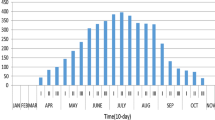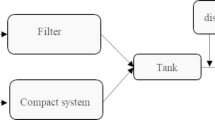Abstract
The purpose of this paper is to investigate the optimization of retention ponds for energy production by a low-head hydropower converter towards smart water grids and new flood adaptation solutions. Flood drainage systems are infrastructures essential in urban areas to control floods, which include retention ponds that can be used as innovative solutions adapted to climate changes and smart water grids to produce energy in a near future and to improve the drainage system elasticity. A catchment-scale water/energy management model is used for designing solutions by defining the characteristics of the urban area and the hydropower converters. The study area is based on Alcântara zone, in a district of Lisbon, a specific down-town zone close to the Tagus river, which has the backwater sea tidal influence. A solution based on the catchment of this area for extreme values of runoff induced by a significant climate changes event in these last years is analysed and then optimized in terms of energy production for different characteristic parameters. Finally, results are shown and discussed to reveal the most suitable solutions.















Similar content being viewed by others
References
Andoh R (2012) European Project Shares Water Knowledge, Hydro International Stormwater. Engineering Nature’s Way. http://www.engineeringnaturesway.co.uk/2012/european-project-shares-water-knowledge/ (accessed in 2012)
Beaulieu RA (2010) National smart water grid: integrated solutions for sustainable fresh water supply. Global Beau Publications, Las Vegas, 978-0-615-42143-8
Bizikova L, Neale T, Burton I (2008) Canadian communities’ guidebook for adaptation to climate change. Including an approach to generate mitigation co-benefits in the context of sustainable development, 1st edn. Environment Canada and University of British Columbia, Vancouver
Breinholt A, Santacoloma PA, Mikkelsen PS, Madsen H, Grum M, Nielsen MK (2008) Evaluation framework for control of integrated urban drainage systems. In: 11ICUD, 11th International Conference on Urban Drainage, Edinburgh, Scotland, 31st August–5th September 2008. University of Sheffield, Sheffield, UK
Bruno GS, Fried L, Hopwood D (2008) Focus on small hydro. Renew Energy Focus 9:54–57
Caxaria GA, Mesquita e Sousa D, Ramos HM (2011) Small scale hydropower: generator analysis and optimization for water supply systems. World Renewable Energy Congress 2011 (Theme: Hydropower Applications (HP)), Linköping, Sweden
Einfalt T, Hatzfeld F, Wagner A, Seltmann J, Castro D, Frerichs S (2009) URBAS: forecasting and management of flash floods in urban areas. Urban Water J 6:369–374
Eum H, Vasan A, Simonovic SP (2012) Integrated reservoir management system for flood risk assessment under climate change. Water Resour Manag 26:3785–3802. doi:10.1007/s11269-012-0103-4
Hoekstra A, Chapagain AK, Aldaya MM, Mekonnen MM (2009) Water footprint manual: state of the art 2009. Water Footprint Network, Enschede
Howe C, Mitchell C (2012) Water sensitive cities. IWA, London
Lee JG, Selvakumar A, Alvi K, Riverson J, Zhen JX, Shoemaker L, Lai F (2012) A watershed-scale design optimization model for stormwater best management practices. Environ Model Softw 37:6–18
Lindström A, Granit J (2012) In: Weinber J (ed) Large-scale water storage in the water, energy and food nexus: perspectives on benefits, risks and best practices. Stockholm International Water Institute (SIWI)
Madsen H, Refsgaard A, Falk AK (2009) Energy optimization of well fields. Ground Water 47:766–771
Meteo.pt (2012) IP Portugal http://www.meteo.pt/pt/oclima/acompanhamento/index.jsp?selTipo=g&selVar=rr&selAno=-1#. Accessed in 2012.
Pender G, Néelz S (2007) Use of computer models of flood inundation to facilitate communication in flood risk management. Environ Hazard 7:106–114
Ramos HM, Borga A, Simão M (2009) New design solutions for low-power energy production in water systems. Water Sci Eng 2(4):69–84
Ramos HM, Kenov KN, Pillet B (2012a) Stormwater storage pond configuration for hydropower solutions: adaptation and optimization. J Sustain Dev 5(8):27
Ramos HM, Simão M, Borga A (2012b) Experiments and CFD analyses for a new reaction micro-hydro propeller with five blades. J Energy Eng. doi:10.1061/(ASCE)EY.1943-7897.0000096
Ramos HM, Simão M, Kenov KN (2012c) Low-head energy conversion: a conceptual design and laboratory investigation of a microtubular hydro propeller. ISRN Mech Eng 2012:1–10. doi:10.5402/2012/846206
Santos RS (2011) Urban floods and constructive measures for its mitigation, MSc thesis at IST. Lisbon
Schneider S, Müller G, Saenger N (2011) Nutzung von geringen Fallhöhen zur Energiegewinnung – Untersuchungen an einer Wasserdruckmaschine (On using small head differences - Investigations on a hydraulic pressure machine), Annual conference on Hydraulic Engineering 2011, Dresden (Germany)
Senior J, Wiemann P, Muller GU (2008) The rotary hydraulic pressure machine for very low head hydropower sites. International Conference on small hydropower. Hidroenergia 2008: “On the crossroads”, Bled, Slovenia
Senior J, Saenger N, Müller G (2011) New hydropower converters for very-low head differences. J Hydraul Res 48:703–714
Sommers GL (2004) Hydropower resources. Encycl Energy 2004:325–332
Talukdar B, Deb D, Srivastava DK (2011) World Environ Water Resour Congr 2011:3978–3989. doi:10.1061/41173(414)415
Tingsanchali T (2012) Urban flood disaster management. Procedia Eng 32:25–37
Wegehenkel M, Kersebaum KC (2008) A first assessment of the impact of climate change on discharge and groundwater recharge in a catchment in Northeastern Germany. J Agrometeorol 10:274–281
Wiemann P, Müller G, James SJ (2009) Review of current developments in low head, small hydropower, Hylow project, University of Southampton. UK
Acknowledgements
The authors wish to thank the Pays de la Loire region for the Envoleo grant and the European Erasmus commission for the erasmus grant through the engineering school of Centrale Nantes, which enable the student to carry out the project. The authors also wish to thank the European Commission through CEHIDRO (Hydraulic Research Centre from the Civil Engineering Department of Instituto Superior Técnico (IST)—Technical University of Lisbon); research project EU HYLOW from the EU 7th Framework Program for Research and Technological Development, (Grant no. 212423), which contributed to the development of this research and also COST Action TU902.
Author information
Authors and Affiliations
Corresponding author
Rights and permissions
About this article
Cite this article
Ramos, H.M., Teyssier, C. & López-Jiménez, P.A. Optimization of Retention Ponds to Improve the Drainage System Elasticity for Water-Energy Nexus. Water Resour Manage 27, 2889–2901 (2013). https://doi.org/10.1007/s11269-013-0322-3
Received:
Accepted:
Published:
Issue Date:
DOI: https://doi.org/10.1007/s11269-013-0322-3




